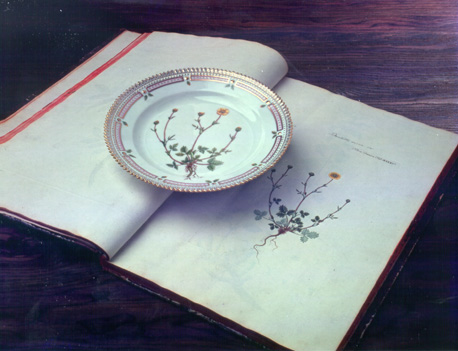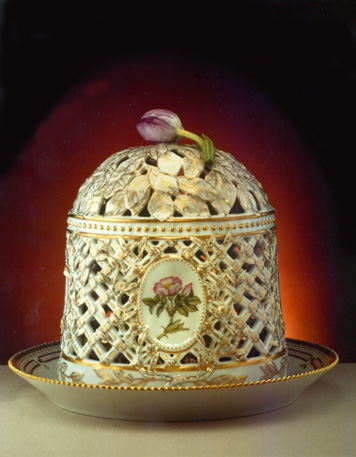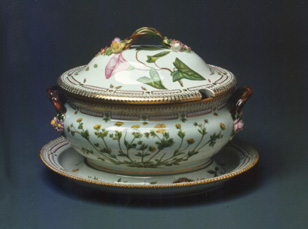Flora Danica, the Dinner Set

Back
| Flora Danica Online Homepage | Search Flora Danica | DNLB HomepageFlora Danica, the Dinner Set |
 |
 It is generally believed that the Flora
Danica dinner set was intended as a present from the Danish king to the Russian empress
Catharine 2.
It is generally believed that the Flora
Danica dinner set was intended as a present from the Danish king to the Russian empress
Catharine 2.
Gifts among princes were supposed to be - princely. The set was ordered in 1790, but Catharine 2 never received it as she died in 1796. The crown prince renewed the order and the set was delivered in 1802. It was never quite complete though, because production had been discontinued by order of the king.
The set was used only at state dinners, birthday parties, weddings and the like. Even so, much has been lost; thus 32 plates were broken on one occasion in 1841. Of the original 1802 pieces some 1500 have survived.
The painting of flowers on porcelain was common enough at end of the 18th century but the ornamentation conformed to aesthetic criteria. The decorations on Flora Danica were not chosen from aesthetic criteria. In tune with the spirit of the Age of Enlightenment it was decided to make exact "scientific" copies of the plates of the highly praised book Flora Danica. It was not easy, however, to transfer the pictures from the square plates to the round or oval shape of the set, and sometimes compromises had to be made.
Johann Christoph Bayer, who had been called in from abroad by Oeder in 1769 to work on the book, was chosen to paint the flowers. The Flora Danica set became his life-work.
 Production was resumed when the daughter of
Christian 9, Alexandra, was to marry the later English King Edward 7. A committee of
Society ladies decided in 1862 on a Flora Danica dinner set for a wedding present. This
set differed in many ways from the original. It was now possible to choose among all the
plates that had served as models for the original set in addition to 1440 new ones.
Production was resumed when the daughter of
Christian 9, Alexandra, was to marry the later English King Edward 7. A committee of
Society ladies decided in 1862 on a Flora Danica dinner set for a wedding present. This
set differed in many ways from the original. It was now possible to choose among all the
plates that had served as models for the original set in addition to 1440 new ones.
The ladies chose the flowers they liked best. Aesthetic considerations carried great weight.
Since then Flora Danica has been on the sales list of the Royal Porcelain Factory (Royal Scandinavia).
The illustrations of the porcelain have kindly been provided by Royal Scandinavia.
© Copyright 1998 Danmarks Natur- og Lægevidenskabelige Bibliotek